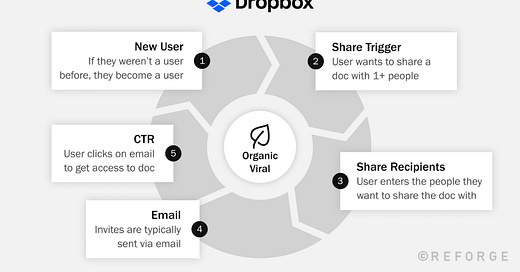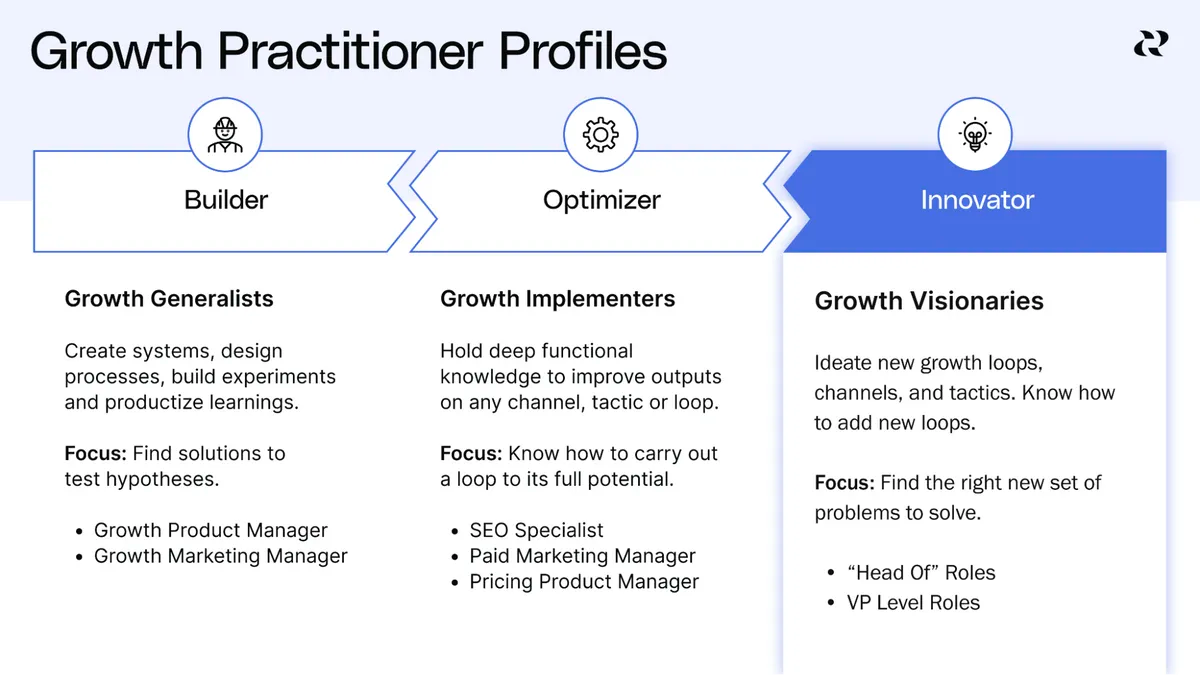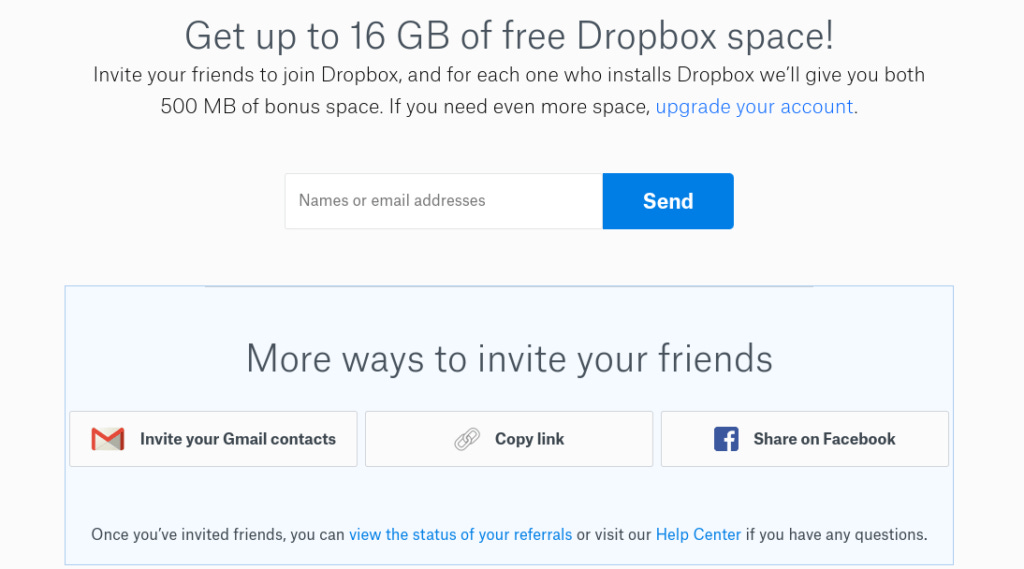Look at the history of Product-led Growth and you’ll see Dropbox’s influence everywhere. Any article or analysis explaining the PLG movement features them—they were so foundational to concepts like viral marketing that even the Wikipedia article for K-factor mentions them by name. So, it’s safe to say I’ve been a fan for a while, and getting to step in to lead the Growth team at this legendary logo has been pretty surreal.
But what’s it look like on the inside?
There’s a lot to cover, so I figured I’d just share my answers to the most common questions I get.
“How is the Growth team structured at Dropbox?”
The Growth team at Dropbox consists of 2 functions: Growth Product Management and Data.
Looking at the Growth Product team is like watching an orchestra of funnel metrics: Growth is all about distribution, and distribution is about finding the best way to get more users to adopt the value through acquisition, activation, monetization, and engagement. Thus, each metric has a Growth Product Manager running the show, supported by dedicated resources from Design, Engineering, and Data.
The Sharing Loop has its own dedicated growth pod focused on accelerating this loop:
The Mobile team focuses on metrics and loops within our mobile apps.
The Growth Infra team is responsible for maintaining growth-owned surfaces (like onboarding or pricing pages) as well as our experimentation platform, in-app messaging, and email.
The Data team supports Growth, Core Product, and Marketing. But let’s face it: the Growth Product team hogs most of the data resources. We simply cannot operate without them!
“What metrics does the Growth team pay attention to at Dropbox?”
I’ve set out the responsibilities simply:
Acquisition is responsible for Top of the Funnel: total sign-ups and B2B sign-ups
Activation is responsible for those sign-ups reaching the first habit loop, which completes activation: Set up, Aha!, Habit, Team invites
Monetization is measured on our ability to convert customers from free to paid, retain them, and trigger expansion: Trial Starts, Free to Paid conversion, ARPA, Expansion, Voluntary & Involuntary Churn, Hand Raisers to sales
Engagement measures weekly active users & teams, which is Dropbox’s core frequency of engagement and something that helps the team know if people receive value from Dropbox at least once a week. But also Shares and Month 12 Retention
We drive these metrics globally and cross-surfaces (mobile, desktop, and web).
“What’s the culture like on the Dropbox Growth team?”
We have a couple of growth cultural themes that we all believe in. Be data driven. Be agile. Have high agency. Exhibit craft. Have a growth mindset.
Growth mindset is one of the hardest ones. The central idea is that we need to learn in order to win. We can’t expect only wins. So, we need to embrace failure and turn that learning into a win.
Learning is everything. We’re constantly asking, “What did we learn in the last seven days? What can we learn in the next seven days? ” Velocity of learning is our growth team’s north star.
Embracing failures is actually the hardest part because organizationally you always try to avoid failures. But at the end of the day, failure is how we learn. We have a Slack channel called #oh-sh1t and we post our failures there. We see these as opportunities because the things that don't work give us the first step toward discovering what will.
Not everybody’s personality fits into the growth team, but the people that are truly curious and really want to try something new are going to thrive.
“What characteristics help someone thrive on the Growth team?”
There are three types of growth personas — the optimizer, the builder, and the innovator:
Individual contributors on the team need to be able to rotate between the optimizer and builder roles. Optimizers are people who have very deep craft in their one specific area. For example, somebody on our activation team probably needs a deep understanding of what it means to set up a customer to get them to an ‘Aha’ moment, to get them into the first habit loop.
As people start to go into more of a leadership position, they need to start figuring out how to build and how to connect activation to acquisition and to engagement and to monetization. Leaders must be able to fill the ‘Innovator’ role, but ultimately, they have to be able to flex: A lot of times, you innovate and then you need to build it out to create sustainability. That requires rotating between the innovator and builder side of the role.
In general, we expect that everyone will cycle through these roles throughout their careers.
“What are common misconceptions about Growth at Dropbox?”
The biggest misconception I see is that people think Dropbox grows because of its referral loop. Now, everyone remembers Dropbox’s legendary referral loop: "Give storage to get storage." It was a genius campaign that flooded our inboxes with referrals:
This growth loop was fantastic and highly productive. In fact, I'd attribute Dropbox's record-breaking rise to the first $1 billion in revenue in part to this loop. However, this loop worked wonderfully for personal use cases. Over the last decade, Dropbox has also focused on B2B use cases, and referral loops on that side just don't work the same way. Nobody in B2B is incentivized to put their reputation on the line in front of their colleagues just to save a few bucks… Instead, file sharing and marketing loops are the main drivers behind Dropbox's growth today.
“What do you think Dropbox does particularly well that sets it apart from other tech companies of a similar size or structure?”
Two things stand out:
Dropbox's ability to balance both B2C and B2B use cases
The enormous scale of the product-led growth model
B2C and B2B
Companies are often categorized into B2C or B2B industries. However, most B2B companies are experiencing a consumerization wave and are starting to resemble consumer apps more closely (we call this “prosumer,” aka professional consumer). Thus, the boundary is beginning to blur, and most B2C companies are trying to enter B2B, while B2B companies are offering B2C use cases. I’d say Dropbox is one of the early pioneers in blurring this line and paving the way for businesses that can do both. Other businesses have followed suit — Notion, Miro, etc. I fundamentally believe that most businesses will have both B2C and B2B use cases in the future.
PLG scale
What other B2B companies have you seen reach $2B+ in ARR via product-led growth? Dropbox’s self-serve model and scale are truly amazing: millions of self-serve paid users, millions of new sign-ups every week... all because of the strength in product-led growth.
“Does Dropbox's history as a PLG pioneer make it easier or harder to lead Growth?”
I say easier! Within the PLG model, the Growth team acts as a 'sales' team for the core product. This means that Growth not only secures a significant seat at the decision-making table but is also fully resourced to deliver impactful results. With these resources comes substantial monetization accountability, as the team is directly responsible for a large percentage of the overall revenue. However, if you ask any member of a Growth team, this responsibility is very much a desired state.
Within the PLG model, the Growth team acts as a 'sales' team for the core product.
This setup also allows the Growth team to have considerable influence over product strategy and execution, ensuring that their initiatives are aligned with broader business objectives. Furthermore, having a historical foundation as a PLG pioneer provides Dropbox with a competitive advantage. They have a proven track record and a deep understanding of how to leverage product functionality to drive user acquisition, conversion, and expansion effectively. This expertise helps navigate the complex dynamics of growth in the competitive tech landscape.
“What are you excited about for Growth at Dropbox in 2024?”
First of all, since Dropbox is essentially the poster child of product-led growth that popularized the concept of organic viral growth through sharing in the tech space 17 years ago, I’m very excited to continue innovating on that flow. We’ve built it out and optimized it, but we have so many ideas on how to really take growth to the next level and become best-in-class.
The second thing is evolving Dropbox beyond file, sync, and share. I’m looking forward to incorporating all the workflow goodness that has been built over the years, such as branding, editing, approving, tracking, signing. We’re going to make hard things easy for our customers.
The third thing is… Product-led Sales! My favorite. I’m excited to strengthen the connection between our product growth and our marketing and sales engines. Dropbox's product-led growth model is undeniable, so boosting that with marketing and sales will be monumental for the next wave of what Dropbox is worth.
Lastly… Dropbox’s vision! The Dropbox origin story is famously tied to a flash drive incident involving its co-founder, Drew Houston. The idea for Dropbox came to Drew when he repeatedly faced the frustration of forgetting his USB flash drive while he was a student at MIT. This recurring problem led him to create a better way to access and synchronize any files across multiple devices without the need to carry around a physical drive. However the problem has evolved even more — and now we are not struggling with flash drives, but content drift within our businesses. The amount of time we waste looking for information across Slack, Notion, Confluence, Airtable, Zoom recordings… the list is infinite. So I’m very excited by Dropbox’s mission to solve this problem with Dash: our universal internal search and answer engine. And I want to be part of this evolution and journey!
—
That’s it for now. You can also check out some of the practical lessons I’ve learned during this time in these articles that I’ve written thus far while in this role:
Try this onboarding email series strategy… it actually works!
Profiling: The onboarding step that transforms your growth efforts
In my next post I will talk about my decision to take a full-time role at Dropbox!
Edited with the help of Jonathan Yagel, who has an amazing blog, too.









Would love if you could dig more into this! What are some examples of marketing loops or product loops you’ve found to be most effective for b2b buyers. What are some of the core user priorities you’ve found that lead to those loops?
“Instead, file sharing and marketing loops are the main drivers behind Dropbox's growth today”
Most content focuses on b2c loops so this would be really valuable.